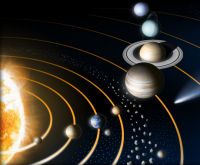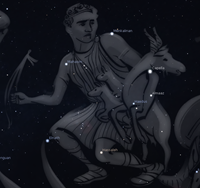 In this month's edition:
In this month's edition:
- Planetary Skylights: AM: Venus, Jupiter, Mercury; PM: Mar, Uranus, Neptune
- Moon: Total Lunar Eclipse
- Meteors: Quarantids
- Comets: Comet 46P/Wirtanen
- Earth: at Perihelion
- January 2019 Sky Charts
- Log in to post comments
 In this month's edition:
In this month's edition:
 This year’s society Christmas meal at the Hare and Hounds was once again a convivial occasion. Nine members made it to the festive banqueting table, the taxi service provided by Mark and Saul ran like clockwork, shaming the normal taxi services... [Read more about Christmas Meal 2018]
This year’s society Christmas meal at the Hare and Hounds was once again a convivial occasion. Nine members made it to the festive banqueting table, the taxi service provided by Mark and Saul ran like clockwork, shaming the normal taxi services... [Read more about Christmas Meal 2018]
Did anyone spot any Geminid meteors?
(Publisher’s note: Andi in Tenerife raises his hand, smugly.)
The evenings (and early part of the mornings) on the relevant dates, were pretty cloudy. The dawn of the 14th was clearer, but at 06:45h skies were beginning to lighten and Mark only saw two (one of these wasn’t a Geminid), so hopefully someone may have fared better. [Read more about Geminids]
 Essential work on the Bruce Observatory is once again required in order to maintain the integrity of the building itself.
Essential work on the Bruce Observatory is once again required in order to maintain the integrity of the building itself.
The telescope and mount itself is in pretty good working order (maybe a good clean required) but the shutters, guttering, south side wall, dome felting and exterior laths all require attention. [Read more about Bruce Observatory]
There are not too many copies of night scenes 2019 remaining. If you would like a copy it’s just £4 to society members and £6 otherwise. They are an indispensable guide for the astronomical year ahead, so don’t delay, once gone that’s it. [Read more about Night Scenes 2019 – a few left!]
 Continuing the tour of stellar objects crossing the meridian line this month: Capella from the constellation Auriga - the sixth brightest star in the night sky; and Epsilon Aurigae - an unusual binary system that lies just below it. [Read more about Crossing the Line: objects of the month]
Continuing the tour of stellar objects crossing the meridian line this month: Capella from the constellation Auriga - the sixth brightest star in the night sky; and Epsilon Aurigae - an unusual binary system that lies just below it. [Read more about Crossing the Line: objects of the month]
NASA launched the spacecraft in 2006; it flew past Pluto in 2015, providing the first close-up views of the dwarf planet. After the successful flyby, NASA set their sights on a destination deep inside the Kuiper Belt, Ultima Thule is that object.
This Kuiper Belt object was discovered by the Hubble Space Telescope in 2014. Officially known as 2014 MU69, it got the nickname Ultima Thule in an online vote. When New Horizons first glimpsed the rocky iceball in August it was just a dot. Good close-up pictures should be available the day after the flyby.
New Horizons will make its closest approach in the wee hours of January 1st hurtling by within 3,500 kilometres (2,200 miles) of Ultima Thule at some 50,700 kph (31,500 mph). It will take about 10 hours to get confirmation that the spacecraft completed — and survived — the encounter. Hopefully, later on New Year’s day we shall get that, so keep an eye on the media. It will take almost two years for New Horizons to beam back all its data on Ultima Thule. A flyby of an even more distant world could be in the offing in the 2020s, if NASA approves another mission extension and the spacecraft remains healthy. [Read more about New Horizons at Ultima Thule]